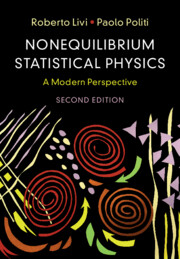Book contents
- Frontmatter
- Dedication
- Contents
- Preface
- Acknowledgments
- Notations
- Abbreviations
- 1 Kinetic Theory and the Boltzmann Equation
- 2 Brownian Motion, Langevin, and Fokker–Planck Equations
- 3 Fluctuations and Their Probability
- 4 Linear Response Theory and Transport Phenomena
- 5 From Equilibrium to Out-of-Equilibrium Phase Transitions: Driven Lattice Gases
- 6 Absorbing Phase Transitions
- 7 Stochastic Dynamics of Surfaces and Interfaces
- 8 Phase-Ordering Kinetics
- 9 Highlights on Pattern Formation
- A Binary Elastic Collisions in the Hard Sphere Gas
- B Maxwell–Boltzmann Distribution in the Uniform Case
- C Physical Quantities from the Boltzmann Equation in the Nonuniform Case
- D Outine of the Chapman–Enskog Method
- E First-order Approximation to Hydrodynamics
- F Spectral Properties of Stochastic Matrices
- G Reversibility and Ergodicity in a Markov Chain
- H The Ising Model
- I The Deterministic KPZ Equation and the Burgers Equation
- J Stochastic Differential Equation for the Energy of the Brownian Particle
- K The Kramers–Moyal Expansion
- L Probability Distributions
- M The Diffusion Equation and the Random Walk
- N Linear Response in Quantum Systems
- O Mathematical Properties of Response Functions
- P The Van der Waals Equation
- Q Derivation of the Ginzburg–Landau Free Energy
- R The Perturbative Renormalization Group for KPZ
- S TASEP: Map Method and Simulations
- T Bridge Model: Mean-field and Simulations
- U The Allen–Cahn Equation
- V The Gibbs–Thomson Relation
- W The Rayleigh–Bénard Instability
- X General Conditions for the Turing Instability
- Y Steady States of the One-Dimensional TDGL Equation
- Z Multiscale Analysis
- Index
5 - From Equilibrium to Out-of-Equilibrium Phase Transitions: Driven Lattice Gases
Published online by Cambridge University Press: 19 June 2025
- Frontmatter
- Dedication
- Contents
- Preface
- Acknowledgments
- Notations
- Abbreviations
- 1 Kinetic Theory and the Boltzmann Equation
- 2 Brownian Motion, Langevin, and Fokker–Planck Equations
- 3 Fluctuations and Their Probability
- 4 Linear Response Theory and Transport Phenomena
- 5 From Equilibrium to Out-of-Equilibrium Phase Transitions: Driven Lattice Gases
- 6 Absorbing Phase Transitions
- 7 Stochastic Dynamics of Surfaces and Interfaces
- 8 Phase-Ordering Kinetics
- 9 Highlights on Pattern Formation
- A Binary Elastic Collisions in the Hard Sphere Gas
- B Maxwell–Boltzmann Distribution in the Uniform Case
- C Physical Quantities from the Boltzmann Equation in the Nonuniform Case
- D Outine of the Chapman–Enskog Method
- E First-order Approximation to Hydrodynamics
- F Spectral Properties of Stochastic Matrices
- G Reversibility and Ergodicity in a Markov Chain
- H The Ising Model
- I The Deterministic KPZ Equation and the Burgers Equation
- J Stochastic Differential Equation for the Energy of the Brownian Particle
- K The Kramers–Moyal Expansion
- L Probability Distributions
- M The Diffusion Equation and the Random Walk
- N Linear Response in Quantum Systems
- O Mathematical Properties of Response Functions
- P The Van der Waals Equation
- Q Derivation of the Ginzburg–Landau Free Energy
- R The Perturbative Renormalization Group for KPZ
- S TASEP: Map Method and Simulations
- T Bridge Model: Mean-field and Simulations
- U The Allen–Cahn Equation
- V The Gibbs–Thomson Relation
- W The Rayleigh–Bénard Instability
- X General Conditions for the Turing Instability
- Y Steady States of the One-Dimensional TDGL Equation
- Z Multiscale Analysis
- Index
Summary
The first part of the chapter is a not-so-small presentation of equilibrium phase transitions, which allows us to introduce key concepts for both equilibrium and nonequilibrium phase transitions. The lattice gas, that is, the Ising model with a conserved order parameter, is an appropriate model to analyze how an equilibrium model can be brought out of equilibrium and to highlight the importance of boundary conditions in nonequilibrium phase transitions. The driven lattice gas, introduced by Katz, Lebowitz, and Spohn around 40 years ago, allows to define the totally asymmetric simple exclusion (TASEP) model and subsequently also the BRIDGE model. The latter is a one-dimensional model displaying a nonequilibrium phase transition with a symmetry breaking between two equivalent classes of particles. This result, considering the short-range character of interactions, would not be possible at equilibrium. In an equally unexpected way, an external breaking of the symmetry (equivalent to the application of a magnetic field to the Ising model) does not make the phase transition disappear.
Keywords
Information
- Type
- Chapter
- Information
- Nonequilibrium Statistical PhysicsA Modern Perspective, pp. 198 - 241Publisher: Cambridge University PressPrint publication year: 2025
